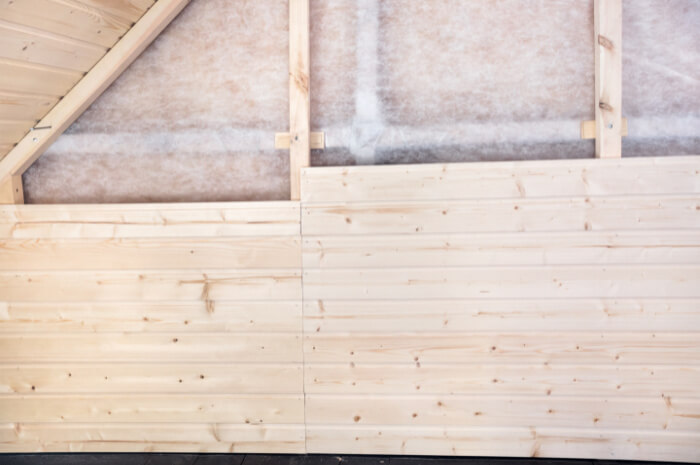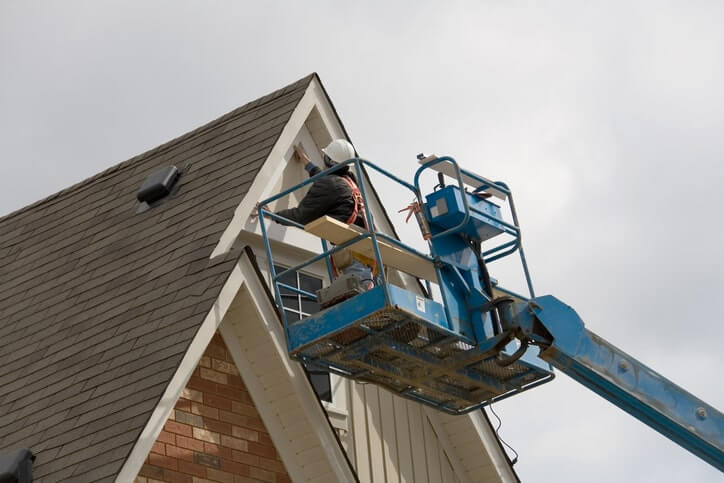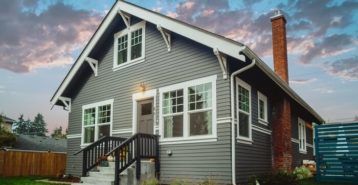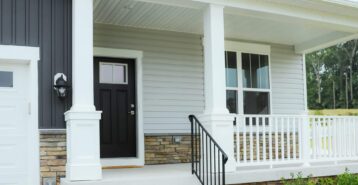Types of Insulated Siding
When deciding on the best type of siding insulation, several factors should be considered. Consider the type of siding being installed and whether the siding is new construction, placed over existing siding, or replaced with the current insulation once the old siding is removed. Below are common types of siding insulation.
- Foam insulation: Adds thermal resistance, moisture and pest control, and noise reduction.
- Foil-backed insulation: Slows heat transfer, making it ideal for cold climates.
- Rigid foam insulation board: Provides moisture control, better air filtration, and thermal performance.
- Thermal wrap: Also known as “house wrap,” provides better air filtration, prevents leakage, and offers better thermal insulation.
Insulated Vinyl Siding
Insulated vinyl siding, or foam-backed siding, is the most popular choice for added energy efficiency. The foam layer boosts the R-value to 2.0-3.5, compared to just 0.61 for non-insulated vinyl. This insulation reduces energy costs year-round by preventing thermal bridging—where hot and cold air pass through wooden studs. It also improves noise reduction and durability. For even greater efficiency, consider pairing it with triple-pane windows.
How Much Does Insulated Vinyl Siding Cost?
All in all, insulated vinyl siding will cost more to install compared to vinyl siding without insulation. While vinyl siding costs between $4.50 and $8.20 per square foot to install, insulated vinyl siding may cost as much as $4 to $12 per square foot of installed siding.
The price may differ depending on the quality of the insulation (for instance – basic, better, or best) and the costs of labor and installation in a particular area. Keep in mind that any siding repairs that need to be made during the insulation will add to the total cost.
The added cost of vinyl siding with insulation is often worth the investment. Most homeowners can save as much as 20% or more on monthly energy bills with effective siding insulation.
Insulated Fiber Cement Siding
Fiber cement siding, like vinyl, often comes with a layer of foam insulation for added efficiency. Its durability naturally shields the insulation from the elements.
Higher R-values offer better protection against heat transfer, but fiber cement typically has an R-value below 1.0, lower than insulated vinyl siding. Despite this, fiber cement remains a top choice due to its strength, weather resistance, and high return on investment (ROI). It can yield over an 80% ROI, especially for older homes needing replacement. Adding insulation further boosts your home’s value. Installation costs range from $6 to $13 per square foot.
Unexpected Issues When Installing Siding Insulation
If you are looking to replace your current siding with insulated siding, the first step is for the contractor to remove your old siding. This process usually takes about one week to complete. Once the professional tears off the old siding material, they may find some underlying issues that need to be repaired.
For instance, if the original insulation or siding was improperly installed or the insulation has deteriorated, there may be an underlying moisture problem. Other issues that can arise when removing siding include rotting and termite or other wildlife damage.
Before installing siding insulation, any repairs will need to be addressed and this will incur an additional fee. With this in mind, when budgeting for your siding project, add 10 to 20 percent to the overall expected cost to account for these unforeseen situations. Of course, it could depend more on the damage extent and the repairs needed.
Finding a Siding Contractor
It’s smart to tap into the knowledge of your siding contractor to help guide you through the buying and selecting process for insulated siding. New insulation can be a significant investment and choosing the right materials for your climate and home design is important. With all the right pieces in place, you should see an increase in your home’s value, enjoy better efficiency, and add curb appeal.
It is recommended that you request between 3 to 5 estimates from siding insulation contractors for comparison. The most expensive quote does not always ensure the best service nor does the least expensive mean inferior work. Check each contractor’s business with the Better Business Bureau for any negative reviews.
Here are a few additional tips to help you navigate the contractor selection process:
Look for All-Inclusive Bids
A contractor’s bid should include everything: materials, labor, home inspection, permit fees, underlayment, flashing, door and window trim, fasteners, caulking, and adhesives. Make sure there are no hidden costs.
Consider Seasonal Factors
Costs can vary depending on the season. Location, peak installation times, and seasonal rates may increase the overall price. Plan to avoid higher costs.
Prepare for Extra Costs
If old siding needs removal, expect extra charges for removal, transport, and disposal. Confirm whether these costs are part of the bid to avoid surprises.
Ensure Permits Are Included
Your contractor should handle any required permits. If a city building permit is necessary for the project, the contractor usually manages this step as part of their service. Make sure this is covered in your agreement.
If you are looking for a quality contractor to complete your siding insulation project, Modernize can help. Our network of siding professionals is well-equipped to guide you on the right decisions for insulated siding and installing the siding on your home.
Compare top-rated siding pros in your area.
Read real homeowner reviews, explore qualifications, and view promotions. Modernize makes it easy to browse professionals and find one that will be perfect for your project.












